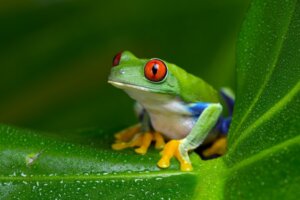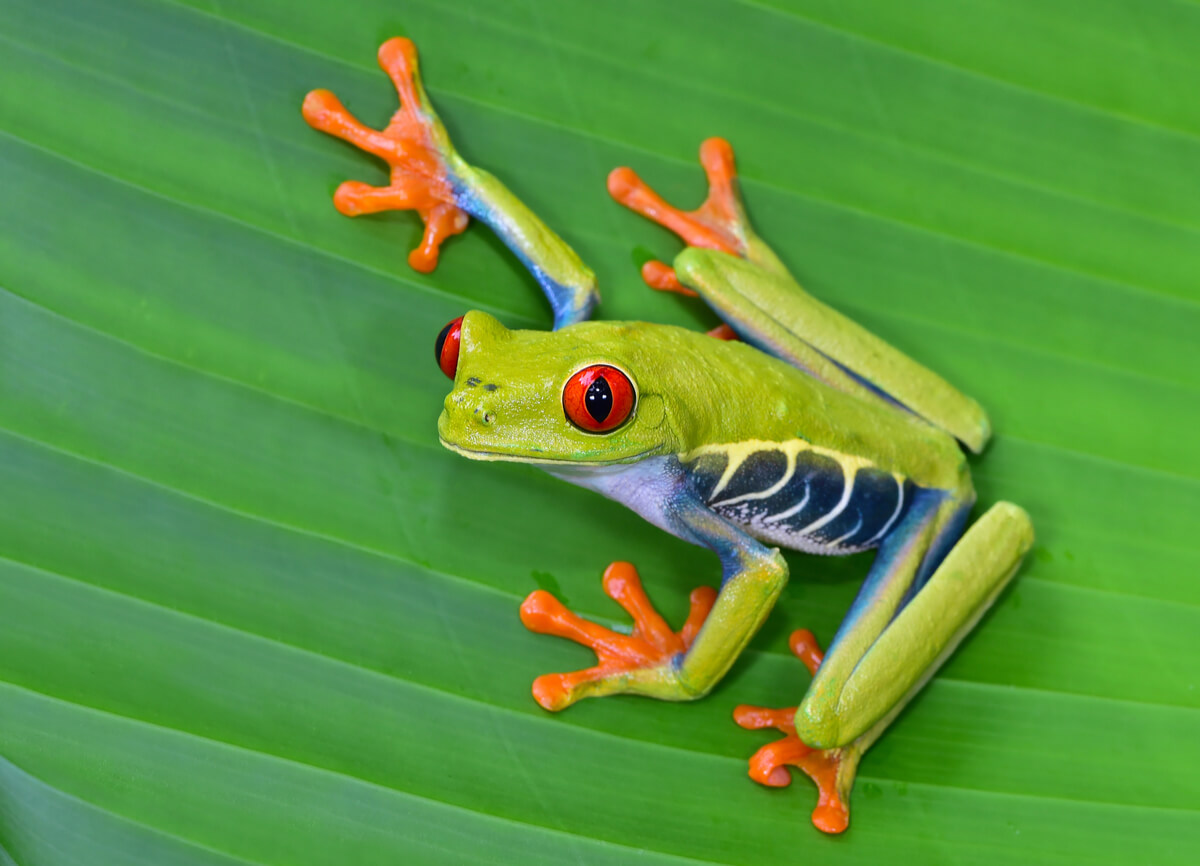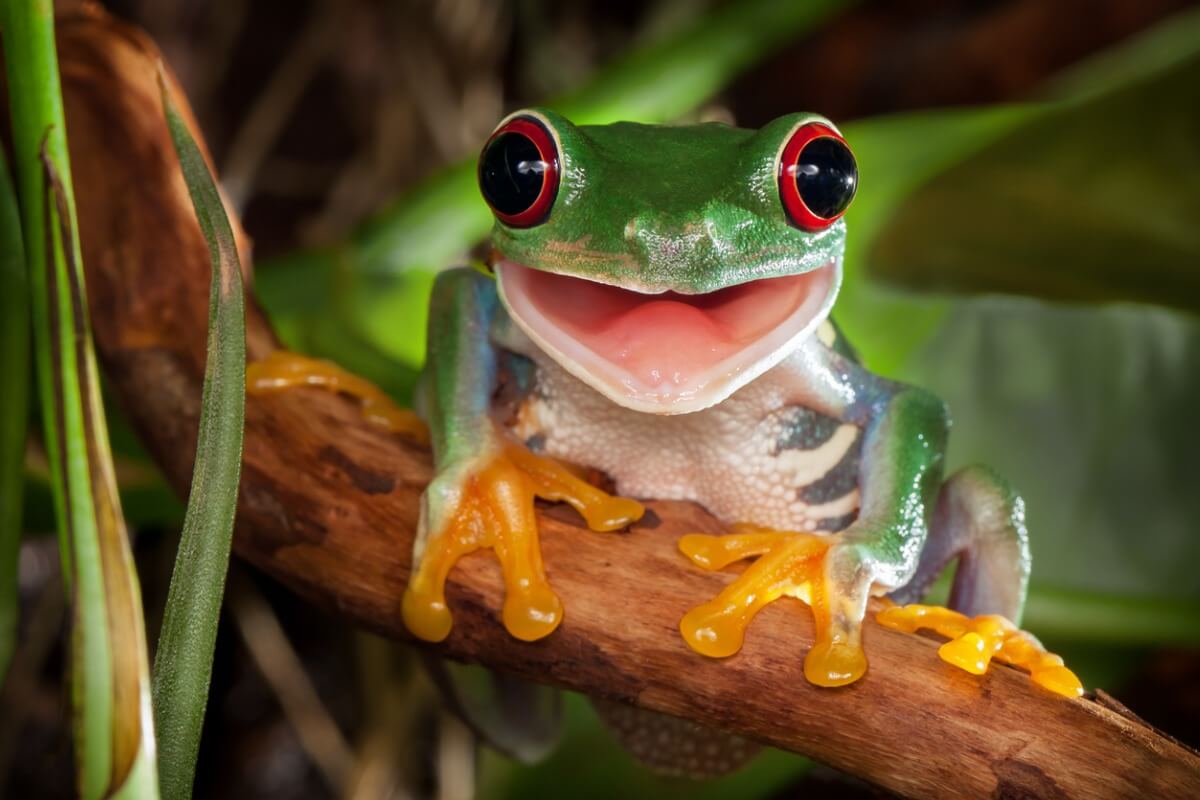Red-Eyed Tree Frog: Habitat and Characteristics


Reviewed and approved by the biologist Samuel Sanchez
The red-eyed tree frog (Agalychnis callidryas) is a small amphibian that has become popular over the years because of its beautiful eyes. This particular feature has been immortalized in many photographs and advertisements all over the internet and in the media.
Because of this, many people have chosen to keep one or more of this species as a pet. However, breeding them in captivity is complex due to their specific requirements, their nocturnal activity, or the environmental conditions of their natural habitat. Below, you’ll find the most relevant information about this curious amphibian.
Habitat of the red-eyed tree frog
This species of frog, belonging to the Hylidae family, inhabits lowland rainforests and can be found in areas near rivers. Its distribution includes rainforests from eastern Honduras to northeastern Colombia, where specimens can also be found swimming in rivers and streams.
In the past, this species was called by several names. However, it’s important to clarify that a recent study based on morphological characteristics and biogeography proposed not to consider the species Agalychnis taylori as a synonym of A. callidryas. The decision was made due to morphological and molecular differences between the two species, even though, at first glance, they may be very similar.
Red-eyed green frogs tend to frequent branches, leaves, and tree trunks, to which they adhere thanks to their suction cup-like toes. This amphibian prefers temperatures between 25 and 30 degrees Celsius during the day and 18-25 degrees at night, where the relative humidity is between 80% and 100%.

Physical characteristics
As its name suggests, the red-eyed tree frog is mainly characterized by the bright green color of its skin and the intensity of the red tone of its eyes. On the other hand, the front and hind legs are orange and the ventral area is notable for its bright blue hue.
Young frogs of this species are born brown and change to green when become adults. Interestingly, they can change their hue to a darker green or reddish brown depending on the environment they’re in.
The species presents a very clear sexual dimorphism, as the males are smaller than the females: they measure 56 millimeters and the females 71 millimeters. And, as mentioned above, this frog has large pads at the end of the toes with suction cups that allow it to move and adhere to the leaves of its habitat.
The behavior of the red-eyed tree frog
The species A. callidryas has nocturnal and arboreal habits. It finds shelter to protect itself from its main predators such as snakes, birds, or bats in tall trees and thickets. Like other frog species, the bright colors of its skin warn those who wish to attack it. However, it should be noted that its skin has a low amount of toxins.
On the other hand, it’s believed that this amphibian’s beautiful eyes are a defense mechanism called startle coloration. With this striking hue, they can scare away predators by abruptly opening their eyeballs and jumping away to seek shelter.
Red-eyed tree frog food
This frog’s diet is carnivorous, as it’s based on flies, grasshoppers, moths, and crickets. The color of its skin allows it to go unnoticed among the leaves of trees, where it waits for insects or other small animals to become its food.
Sometimes this species can feed on other smaller frogs as long as they fit in its mouth. On the other hand, younger frogs feed on fruit flies and pinhead crickets. In captivity, they may feed on mealworms, wax moths, or small specimens of various orthopteran species.
Reproduction of the red-eyed tree frog
The musical mating ritual of the red-eyed tree frog begins with the loud croaking of the male, which is quickly joined by adjacent males. All males begin croaking and jumping from leaf to leaf to establish a territory and attract females. Interestingly, it has been observed that males of this species tremble when the croaking is at its climax.
After the call to the female, two males are likely to confront each other to demonstrate their strength. Finally, and without attracting attention, the females slowly descend from the treetops and the males, as soon as they see her, race to get to her first.
The red-eyed tree frog usually lays its eggs in vegetation overhanging the water, as the tadpoles slip through the leaves and fall into the flowing environment when they hatch.
The male intercepts the female and embraces her in a position known as amplexus. The pair may remain in this position for days until the female decides to lay her eggs. At this moment, she releases the eggs on a leaf and the male immediately fertilizes them externally. As we’ve said before, these eggs are placed just above bodies of water.

Conservation status
Currently, the red-eyed tree frog isn’t a threatened species, as its conservation status according to the International Union for Conservation of Nature (IUCN) is “Least Concern (LC)”. However, deforestation and pollution of its natural habitat are its main threats, apart from the consequences of global warming.
As you’ll have seen, the red-eyed tree frog is one of the most beautiful and curious animals on the planet. Its reproductive behavior and its ability to defend itself are some of its most striking aspects. However, the species could be affected in the future if deforestation of its habitat increases in the coming years.
The red-eyed tree frog (Agalychnis callidryas) is a small amphibian that has become popular over the years because of its beautiful eyes. This particular feature has been immortalized in many photographs and advertisements all over the internet and in the media.
Because of this, many people have chosen to keep one or more of this species as a pet. However, breeding them in captivity is complex due to their specific requirements, their nocturnal activity, or the environmental conditions of their natural habitat. Below, you’ll find the most relevant information about this curious amphibian.
Habitat of the red-eyed tree frog
This species of frog, belonging to the Hylidae family, inhabits lowland rainforests and can be found in areas near rivers. Its distribution includes rainforests from eastern Honduras to northeastern Colombia, where specimens can also be found swimming in rivers and streams.
In the past, this species was called by several names. However, it’s important to clarify that a recent study based on morphological characteristics and biogeography proposed not to consider the species Agalychnis taylori as a synonym of A. callidryas. The decision was made due to morphological and molecular differences between the two species, even though, at first glance, they may be very similar.
Red-eyed green frogs tend to frequent branches, leaves, and tree trunks, to which they adhere thanks to their suction cup-like toes. This amphibian prefers temperatures between 25 and 30 degrees Celsius during the day and 18-25 degrees at night, where the relative humidity is between 80% and 100%.

Physical characteristics
As its name suggests, the red-eyed tree frog is mainly characterized by the bright green color of its skin and the intensity of the red tone of its eyes. On the other hand, the front and hind legs are orange and the ventral area is notable for its bright blue hue.
Young frogs of this species are born brown and change to green when become adults. Interestingly, they can change their hue to a darker green or reddish brown depending on the environment they’re in.
The species presents a very clear sexual dimorphism, as the males are smaller than the females: they measure 56 millimeters and the females 71 millimeters. And, as mentioned above, this frog has large pads at the end of the toes with suction cups that allow it to move and adhere to the leaves of its habitat.
The behavior of the red-eyed tree frog
The species A. callidryas has nocturnal and arboreal habits. It finds shelter to protect itself from its main predators such as snakes, birds, or bats in tall trees and thickets. Like other frog species, the bright colors of its skin warn those who wish to attack it. However, it should be noted that its skin has a low amount of toxins.
On the other hand, it’s believed that this amphibian’s beautiful eyes are a defense mechanism called startle coloration. With this striking hue, they can scare away predators by abruptly opening their eyeballs and jumping away to seek shelter.
Red-eyed tree frog food
This frog’s diet is carnivorous, as it’s based on flies, grasshoppers, moths, and crickets. The color of its skin allows it to go unnoticed among the leaves of trees, where it waits for insects or other small animals to become its food.
Sometimes this species can feed on other smaller frogs as long as they fit in its mouth. On the other hand, younger frogs feed on fruit flies and pinhead crickets. In captivity, they may feed on mealworms, wax moths, or small specimens of various orthopteran species.
Reproduction of the red-eyed tree frog
The musical mating ritual of the red-eyed tree frog begins with the loud croaking of the male, which is quickly joined by adjacent males. All males begin croaking and jumping from leaf to leaf to establish a territory and attract females. Interestingly, it has been observed that males of this species tremble when the croaking is at its climax.
After the call to the female, two males are likely to confront each other to demonstrate their strength. Finally, and without attracting attention, the females slowly descend from the treetops and the males, as soon as they see her, race to get to her first.
The red-eyed tree frog usually lays its eggs in vegetation overhanging the water, as the tadpoles slip through the leaves and fall into the flowing environment when they hatch.
The male intercepts the female and embraces her in a position known as amplexus. The pair may remain in this position for days until the female decides to lay her eggs. At this moment, she releases the eggs on a leaf and the male immediately fertilizes them externally. As we’ve said before, these eggs are placed just above bodies of water.

Conservation status
Currently, the red-eyed tree frog isn’t a threatened species, as its conservation status according to the International Union for Conservation of Nature (IUCN) is “Least Concern (LC)”. However, deforestation and pollution of its natural habitat are its main threats, apart from the consequences of global warming.
As you’ll have seen, the red-eyed tree frog is one of the most beautiful and curious animals on the planet. Its reproductive behavior and its ability to defend itself are some of its most striking aspects. However, the species could be affected in the future if deforestation of its habitat increases in the coming years.
All cited sources were thoroughly reviewed by our team to ensure their quality, reliability, currency, and validity. The bibliography of this article was considered reliable and of academic or scientific accuracy.
- McCranie, J. R., Sunyer, J., & Martínez-Fonseca, J. G. (2019). Comments and updates to “Guía Ilustrada de Anfibios y Reptiles de Nicaragua along with taxonomic and related suggestions associated with the herpetofauna of Nicaragua. Revista Nicaraguense de Biodiversidad, 52, 1-44. Recogido el 29 de septiembre de 2021 de: https://www.researchgate.net/publication/337830371_Comments_and_updates_to_Guia_Ilustrada_de_Anfibios_y_Reptiles_de_Nicaragua_along_with_taxonomic_and_related_suggestions_associated_with_the_herpetofauna_of_Nicaragua_REVISTA_NICARAGUENSE_DE_BIODIVERSI
- Boman, B. 2002. “Agalychnis callidryas” (On-line), Animal Diversity Web. Recogido el 29 de septiembre de 2021 de: https://animaldiversity.org/accounts/Agalychnis_callidryas/
- UCN SSC Amphibian Specialist Group. 2020. Agalychnis callidryas. The IUCN Red List of Threatened Species 2020: e.T55290A3028059. Recogido el 3 de octubre de 2021 de:https://www.iucnredlist.org/species/55290/3028059
This text is provided for informational purposes only and does not replace consultation with a professional. If in doubt, consult your specialist.








